How to Boost Customer Retention by 20% with Marketing Tech

Improving customer retention by 20% with marketing technology involves leveraging tools for personalized communication, analyzing customer data to understand behavior, and automating engagement strategies to build stronger relationships and loyalty.
In today’s competitive landscape, **how to use marketing technology to improve customer retention by 20%** is a critical question for businesses aiming for sustainable growth. By strategically implementing the right tools and tactics, companies can foster stronger customer relationships, increase loyalty, and ultimately drive significant revenue gains.
Unlock Customer Loyalty: The Power of Marketing Technology
Marketing technology, or martech, has revolutionized how businesses interact with their customers. It’s no longer just about acquiring new customers; it’s about nurturing existing relationships to maximize lifetime value. Understanding how to harness the power of martech can significantly improve your customer retention rates.
Personalized Communication
One of the most effective ways to improve customer retention is through personalized communication. Martech tools enable you to tailor your messaging based on individual customer preferences and behaviors.
Data-Driven Insights
Martech platforms provide valuable data insights that can help you understand your customers better. This includes tracking their purchase history, website activity, and engagement with your marketing campaigns.
- Analyze customer data to identify trends and patterns.
- Use insights to segment your audience and create targeted campaigns.
- Monitor customer feedback and reviews to identify areas for improvement.
By leveraging these strategies, you can create more meaningful interactions with your customers, leading to increased loyalty and retention. Personalized communication and data-driven insights work hand in hand to create a customer-centric approach.
Customer Relationship Management: The Cornerstone of Retention
A Customer Relationship Management (CRM) system is the backbone of any customer retention strategy. It provides a centralized platform to manage customer interactions, track their journey, and personalize their experience.
Centralized Customer Data
A CRM system consolidates all customer data into a single, accessible location. This allows your team to have a complete view of each customer, including their contact information, purchase history, and communication preferences.
Automated Workflows
CRMs offer automated workflows that streamline customer interactions and ensure timely follow-up. This can include automated email campaigns, task reminders for sales and support teams, and personalized onboarding sequences.

- Implement a CRM system that integrates with your other marketing tools.
- Train your team on how to use the CRM effectively.
- Regularly update and maintain your CRM data.
A well-implemented CRM system is essential for creating a seamless and personalized customer experience. By providing a centralized platform for managing customer interactions, CRMs empower businesses to build stronger relationships and improve retention rates. It’s about knowing your customer and providing the best service possible.
Email Marketing: Nurturing Relationships and Driving Loyalty
Email marketing remains a powerful tool for customer retention. It allows you to stay in touch with your customers, provide valuable content, and promote special offers.
Segmentation and Targeting
Segmenting your email list based on customer demographics, purchase history, and engagement levels allows you to send targeted messages that resonate with each individual.
Personalized Content
Personalizing your email content with customer names, product recommendations, and relevant offers can significantly increase engagement and retention.
- Use email marketing automation to send triggered emails based on customer behavior.
- Provide valuable content that educates and entertains your audience.
- Offer exclusive discounts and promotions to loyal customers.
Email marketing, when done strategically, can be a highly effective way to nurture customer relationships and drive loyalty. It’s about providing value, staying relevant, and making your customers feel appreciated. A thoughtful email strategy is a key component of improving customer retention.
Leveraging Social Media for Customer Engagement
Social media platforms provide an excellent opportunity to engage with your customers, build a community, and address their concerns in real-time. Actively managing your social media presence can significantly improve customer satisfaction and retention.
Utilize social media to gather feedback. Understand your audience’s sentiment towards your services.
Active Listening
Monitoring social media channels for mentions of your brand, product, or service allows you to address customer concerns promptly and engage in meaningful conversations.
Community Building
Creating a vibrant online community around your brand can foster a sense of belonging among your customers, encouraging them to stay loyal and engaged.

Social media can be used to display products or services in ways not previously possible. Showcase the value you bring to your customers.
- Respond to customer inquiries and complaints in a timely and professional manner.
- Share valuable content that resonates with your audience.
- Run contests and promotions to engage your followers.
By actively engaging with your customers on social media, you can build stronger relationships, foster loyalty, and improve retention rates. Social media platforms are a powerful tool for strengthening the bond between your brand and your customers. Make your audience feel heard and valued.
Data Analytics: Measuring and Optimizing Retention Efforts
Data analytics is crucial for measuring the effectiveness of your customer retention strategies. By tracking key metrics and analyzing customer behavior, you can identify areas for improvement and optimize your efforts.
Key Performance Indicators (KPIs)
Identifying and tracking key performance indicators (KPIs) such as customer retention rate, customer lifetime value, and churn rate is essential for understanding the health of your customer base.
A/B Testing
A/B testing different marketing strategies, such as email subject lines, website designs, and promotional offers, can help you identify what resonates best with your audience and improve retention rates.
Data analytics is useless without clear goals. Establish achievable benchmarks to reach.
- Implement analytics tools to track customer behavior across all touchpoints.
- Regularly monitor your KPIs to identify trends and patterns.
- Use A/B testing to optimize your marketing strategies.
By leveraging data analytics, you can make informed decisions about your retention strategies and optimize your efforts for maximum impact. It’s about using data to understand your customers and make better decisions that are in line with customer interest. Data analytics is critical for making informed decisions and driving continuous improvement.
Personalization Technologies: Tailoring Experiences for Retention
Personalization technologies are now at the forefront of enhancing customer retention. These tools allow businesses to create tailored experiences that resonate with individual customers.
AI-Driven Personalization
AI can analyze vast amounts of customer data to predict preferences and behaviors, enabling highly personalized recommendations and interactions. This might include suggesting products based on AI.
Dynamic Content
Dynamic content tools allow websites and apps to change their content based on who is viewing it. This can include personalized greetings, product suggestions, or targeted offers.
Make sure personalization is data driven. Always be mindful of privacy concerns.
- Implement AI-driven personalization tools to enhance customer experiences.
- Use dynamic content to tailor website and app experiences.
- Offer personalized rewards and incentives to loyal customers.
By implementing effective personalization technologies, businesses can significantly improve customer satisfaction and retention rates. Use cutting edge technology to build stronger relationships and foster greater loyalty. Keep in mind, though, that the human element should never be fully removed.
| Key Point | Brief Description |
|---|---|
| 🔑 CRM Implementation | Centralize customer data for personalized interactions. |
| 📧 Email Marketing | Nurture customer relationships with targeted content. |
| 📣 Social Media Engagement | Actively engage with customers and build community. |
| 📊 Data Analytics | Measure and optimize retention strategies with data insights. |
5 Tips on How to Use Marketing Technology to Improve Customer Retention by 20%
▼
Begin by selecting a CRM system that suits your business needs. A well-integrated CRM is critical to centralizing your customer data and enabling personalized interactions.
▼
Craft segmented and personalized email campaigns to nurture your customers. Provide value through exclusive content and offers relevant to their interests and prior purchases.
▼
Actively engage with your customers on social platforms. Address their concerns promptly and foster a community to strengthen loyalty and increase overall brand retention.
▼
Utilize analytics tools to track customer behavior and measure the effectiveness of various marketing strategies. Optimize campaigns for maximum impact based on data and engagement.
▼
Absolutely! Implement AI-driven personalization tools to create unique customer experiences. Tailor content, product suggestions, and offers based on individual preferences for improved satisfaction.
Conclusion
Implementing **marketing technology** strategically can significantly improve customer retention. By leveraging CRM systems, email marketing, social media engagement, data analytics, and personalized technologies, businesses can foster stronger customer relationships, increase loyalty, and achieve a 20% boost in retention rates.





